
Where can I find a valid exam dump for Microsoft AZ-103? Dumpsdemo shares the latest and effective Microsoft az-103 exam questions and answers, online practice tests, and the most authoritative Microsoft exam experts update az-103 exam questions throughout the year.
Get the full az-103 exam dumps selection: https://www.leads4pass.com/az-103.html (397 Q&As). Pass the exam with ease!
Microsoft az-103 Exam Video
Table of Contents:
- Latest Microsoft az-103 google drive
- Effective Microsoft az-103 exam practice questions
- Related az-103 Popular Exam resources
- leads4pass Year-round Discount Code
- What are the advantages of leads4pass?
Latest Microsoft az-103 google drive
[PDF] Free Microsoft az-103 pdf dumps download from Google Drive: https://drive.google.com/open?id=1xgSGajuptQs0q0f5u-nwIDW0F3eRPWpC
Exam AZ-103: Microsoft Azure Administrator: https://docs.microsoft.com/en-us/learn/certifications/exams/az-103
Starting on May 1, 2019, you only need to pass Exam AZ-103 to earn this certification. This new exam combines the skills covered in AZ-100 and AZ-101 (which retired on May 1, 2019), with the majority of the new exam coming from AZ-100.
Candidates for this exam are Azure Administrators who manage cloud services that span storage, security, networking, and compute cloud capabilities. Candidates have a deep understanding of each service across the full IT lifecycle and take requests for infrastructure services, applications, and environments. They make recommendations on services to use for optimal performance and scale, as well as provision, size, monitor, and adjust resources as appropriate.
Candidates for this exam should have proficiency in using PowerShell, the Command Line Interface, Azure Portal, ARM templates, operating systems, virtualization, cloud infrastructure, storage structures, and networking.
Skills measured
- A NEW VERSION OF THIS EXAM, AZ-104, WILL BE AVAILABLE ON MARCH 31, 2020. You will be able to take this exam until it retires on June 30, 2020. Please download the skills measured document below to see what will be changing.
- NOTE: The bullets that appear below each of the skills measured in the document below are intended to illustrate how we are assessing that skill. This list is not definitive or exhaustive.
- Manage Azure subscriptions and resources (15-20%)
- Implement and manage storage (15-20%)
- Deploy and manage virtual machines (VMs) (15-20%)
- Configure and manage virtual networks (30-35%)
- Manage identities (15-20%)
Latest updates Microsoft az-103 exam practice questions
QUESTION 1
You need to configure the Azure ExpressRoute circuits.
How should you configure Azure ExpressRoute routing? To answer, drag the appropriate configurations to the correct
locations. Each configuration may be used once, more than once, or not at all.
You may need to drag the split bar between panes or scroll to view content.
NOTE: Each correct selection is worth one point.
Select and Place:

Correct Answer:

QUESTION 2
You have a Microsoft SQL Server Always On availability group on Azure virtual machines. You need to configure an
Azure internal load balancer as a listener for the availability group. What should you do?
A. Enable Floating IP.
B. Set Session persistence to Client IP and protocol.
C. Set Session persistence to Client IP.
D. Create an HTTP health probe on port 1433.
Correct Answer: A
Incorrect Answers:
D: The Health probe is created with the TCP protocol, not with the HTTP protocol.
References:
https://docs.microsoft.com/en-us/azure/virtual-machines/windows/sql/virtual-machines-windows-portal-sql-alwayson-int-listener
QUESTION 3
You have an Azure subscription named Subscription1 that is used be several departments at your company.
Subscription1 contains the resources in the following table:
Another administrator deploys a virtual machine named VM1 and an Azure Storage account named Storage2 by using a
single Azure Resource Manager template.
You need to view the template used for the deployment.
From which blade can you view the template that was used for the deployment?
A. RG1
B. VM1
C. Storage1
D. Container1
Correct Answer: A
1. View template from deployment history
Go to the resource group for your new resource group. Notice that the portal shows the result of the last deployment.
Select this link.
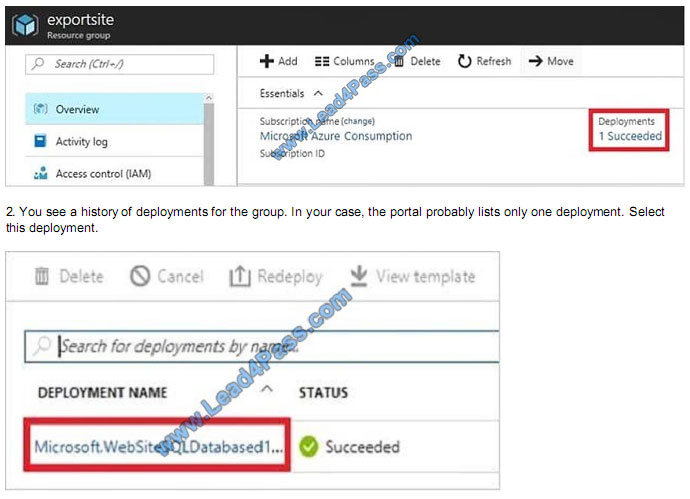
The portal displays a summary of the deployment. The summary includes the status of the deployment and its
operations and the values that you provided for parameters. To see the template that you used for the deployment,
select View template.

References: https://docs.microsoft.com/en-us/azure/azure-resource-manager/resource-manager-export-template
QUESTION 4
Note: This question is part of a series of questions that present the same scenario. Each question in the series contains
a unique solution that might meet the stated goals.
Some question sets might have more than one correct solution, while others might not have a correct solution.
After you answer a question in this section, you will NOT be able to return to these questions will not appear m the
review screen.
You manage a virtual network named VNetl1 that is hosted in the West US Azure region.
VNetl1 hosts two virtual machines named VM1 and VM2 that run Windows Server. You need to inspect all the network
traffic from VM1 to VM2 for a period of three hours.
Solution: From Azure Network Watcher, you create a packet capture.
Does this meet the goal?
A. Yes
B. No
Correct Answer: A
Azure Network Watcher provides tools to monitor, diagnose, view metrics, and enable or disable logs for resources in
an Azure virtual network. Capture packets to and from a VM Advanced filtering options and fine-tuned controls, such as
the ability to set time and size limitations, provide versatility. The capture can be stored in Azure Storage, on the VM\\’s
disk, or both. You can then analyze the capture file using several standard network capture analysis tools. Network
Watcher variable packet capture allows you to create packet capture sessions to track traffic to and from a virtual
machine. Packet capture helps to diagnose network anomalies both reactively and proactivity.
References: https://docs.microsoft.com/en-us/azure/network-watcher/network-watcher-monitoring-overview
QUESTION 5
You have an on-premises data center and an Azure subscription. The data center contains two VPN devices. The
subscription contains an Azure virtual network named VNet1. VNet1 contains a gateway subnet.
You need to create a site-to-site VPN. The solution must ensure that is a single instance of an Azure VPN gateway fails,
or a single on-premises VPN device fails, the failure will not cause an interruption that is longer than two minutes.
What is the minimum number of public IP addresses, virtual network gateways, and local network gateways required in
Azure? To answer, select the appropriate options in the answer area;
NOTE: Each correct selection is worth one point.
Hot Area: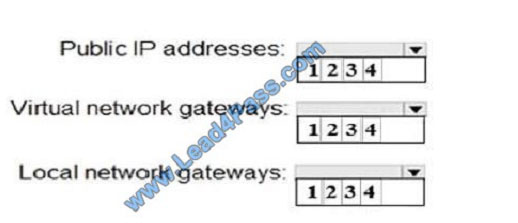
Correct Answer:
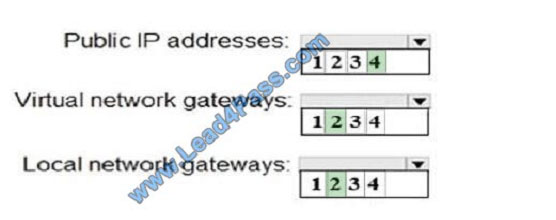
Box 1: 4
Two public IP addresses in the on-premises data center, and two public IP addresses in the VNET. The most reliable
option is to combine the active-active gateways on both your network and Azure, as shown in the diagram below.

Box 2: 2 Every Azure VPN gateway consists of two instances in an active-standby configuration. For any planned
maintenance or unplanned disruption that happens to the active instance, the standby instance would take over
(failover) automatically, and resume the S2S VPN or VNet-to-VNet connections. Box 3: 2 Dual-redundancy: active-
active VPN gateways for both Azure and on-premises networks
References: https://docs.microsoft.com/en-us/azure/vpn-gateway/vpn-gateway-highlyavailable
QUESTION 6
Your company has an Azure subscription named Subscription1.
The on-premises network contains the physical servers shown in the following table.
You plan to use Azure Site Recovery to migrate the on-premises servers to Subscription1.
You need to identify which servers can be migrated.
Which two servers should you identify? Each correct answer presents part of the solution.
NOTE: Each correct selection is worth one point.
A. Server1
B. Server2
C. Server3
D. Server4
E. Server5
F. Server6
Correct Answer: BE
References: https://docs.microsoft.com/en-us/azure/site-recovery/vmware-physical-azure-support-matrix
QUESTION 7
You have an Azure Active Directory (Azure AD) tenant named contosocloud.onmicrosoft.com.
Your company has a public DNS zone for contoso.com.
You add contoso.com as a custom domain name to Azure AD.
You need to ensure that Azure can verify the domain name.
Which type of DNS record should you create?
A. PTR
B. MX
C. NSEC3
D. RRSIG
Correct Answer: B
QUESTION 8
You have an Azure Service Bus.
You create a queue named Queue1. Queue1 is configured as shown in the following exhibit.
Use the drop-down menus to select the answer choice that completes each statement based on the information
presented in the graphic. NOTE: Each correct selection is worth one point.
Hot Area:
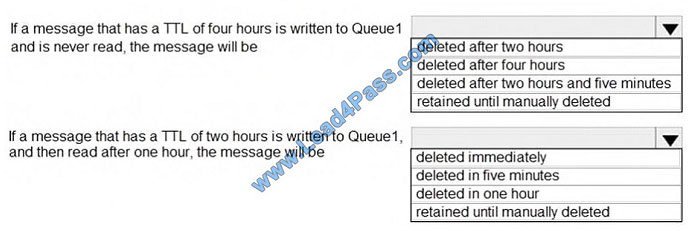
Correct Answer:
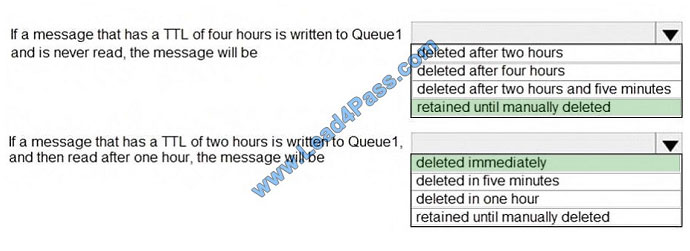
QUESTION 9
HOTSPOT
You enable password reset for contoso.onmicrosoft.com as shown in the Password Reset exhibit (Click the Password
Reset tab.)

You configure the authentication methods for password reset as shown in the Authentication Methods exhibit. (Click the
Authentication Methods tab.)
For each of the following statements, select Yes if the statement is true. Otherwise, select No.
NOTE: Each correct selection is worth one point.
You enable password reset for contoso.onmicrosoft.com as shown in the Password Reset exhibit (Click the Password
Reset tab.)
You configure the authentication methods for password reset as shown in the Authentication Methods exhibit. (Click the
Authentication Methods tab.)
For each of the following statements, select Yes if the statement is true. Otherwise, select No.
NOTE: Each correct selection is worth one point.

Hot Area:

Correct Answer:

Box 1: No
Two methods are required.
ox 2: No
Self-service password reset is only enabled for Group2, and User1 is not a member of Group2.
Box 3: Yes
As a User Administrator User3 can add security questions to the reset process.
References:
https://docs.microsoft.com/en-us/azure/active-directory/authentication/quickstart-sspr
https://docs.microsoft.com/en-us/azure/active-directory/authentication/active-directory-passwords-faq
QUESTION 10
Your Azure environment contains an application gateway and custom apps.
Another administrator modifies the application gateway and the apps to use HTTP over TCP port 8080.
Users report that they can no longer connect to the apps.
You suspect that the cause of the issue is a change in the configuration of the application gateway.
You need to modify the application gateway to resolve the issue.
What should you do from the Azure portal?
A. Answer: See below.
Correct Answer: A
Step 1:
Select Networking and then select Application Gateway in the Featured list, and select the application gateway, and
select the settings.
Step 2:
Click HTTP for the protocol of the listener and make sure that the port is defined as 443.
References: https://docs.microsoft.com/en-us/azure/application-gateway/create-ssl-portal
QUESTION 11
You need to create an Azure Storage account that meets the following requirements:
Minimizes costs
Supports hot, cool, and archive blob tiers
Provides fault tolerance if a disaster affects the Azure region where the account resides
How should you complete the command? To answer, select the appropriate options in the answer area; NOTE: Each
correct selection is worth one point
Hot Area:
Correct Answer:

Box 1: StorageV2
You may only tier your object storage data to hot, cool, or archive in Blob storage and General Purpose v2 (GPv2)
accounts. General Purpose v1 (GPv1) accounts do not support tiering.
General-purpose v2 accounts deliver the lowest per-gigabyte capacity prices for Azure Storage, as well as industry-
competitive transaction prices.
Box 2: Standard_GRS
Geo-redundant storage (GRS): Cross-regional replication to protect against region-wide unavailability.
Incorrect Answers:
Locally-redundant storage (LRS): A simple, low-cost replication strategy. Data is replicated within a single storage scale
unit.
Read-access geo-redundant storage (RA-GRS): Cross-regional replication with read access to the Replica; RA-GRS
provides read-only access to the data in the secondary location, in addition to georeplication across two regions, but is
more
expensive compared to GRS.
References:
https://docs.microsoft.com/en-us/azure/storage/common/storage-redundancy-grs
https://docs.microsoft.com/en-us/azure/storage/blobs/storage-blob-storage-tiers
QUESTION 12
You have an Azure subscription named Subscription1. Subscription1 contains two Azure virtual machines named VM1
and VM2. VM1 and VM2 run Windows Server 2016.
VM1 is backed up daily by Azure Backup without using the Azure Backup agent.
VM1 is affected by ransomware that encrypts data;
You need to restore the latest backup of VM1.
To which location can you restore the backup? To answer, select the appropriate options in the answer area;
NOTE: Each correct selection is worth one point.
Hot Area:
Correct Answer:

Box 1: VM1 only To restore files or folders from the recovery point, go to the virtual machine and choose the desired
recovery point. Box 2: A new Azure virtual machine only On the Restore configuration blade, you have two choices:
Create virtual machine Restore disks
References: https://docs.microsoft.com/en-us/azure/backup/backup-azure-restore-files-from-vm
https://docs.microsoft.com/en-us/azure/backup/backup-azure-arm-restore-vms
QUESTION 13
You create a virtual machine scale set named Scale1. Scale1 is configured as shown in the following exhibit.
Use the drop-down menus to select the answer choice that completes each statement based on the information
presented in the graphic.
Hot Area:

Correct Answer:

Box 1:
The Autoscale scale out rule increases the number of VMs by 2 if the CPU threshold is 80% or higher. The initial
instance count is 4 and rises to 6 when the 2 extra instances of VMs are added.
Box 2:
The Autoscale scale in rule decreases the number of VMs by 4 if the CPU threshold is 30% or lower. The initial instance
count is 4 and thus cannot be reduced to 0 as the minimum instances is set to 2.
Instances are only added when the CPU threshold reaches 80%.
References:
https://docs.microsoft.com/en-us/azure/azure-monitor/platform/autoscale-overview
https://docs.microsoft.com/en-us/azure/azure-monitor/platform/autoscale-best-practices
https://docs.microsoft.com/en-us/azure/azure-monitor/platform/autoscale-common-scale-patterns
Related az-103 Popular Exam resources
leads4pass Year-round Discount Code

What are the advantages of leads4pass?
leads4pass employs the most authoritative exams from Microsoft, Cisco, CompTIA, citrix, EMC, etc. We update exam data throughout the year. Highest pass rate! We have a large user base. We are an industry leader!
Choose leads4pass to pass the exam with ease!

Summarize:
It’s not easy to pass the Microsoft az-103 exam, but with accurate learning materials and proper practice, you can crack the exam with excellent results. https://www.leads4pass.com/az-103.html provides you with the most relevant learning materials that you can use to help you prepare.